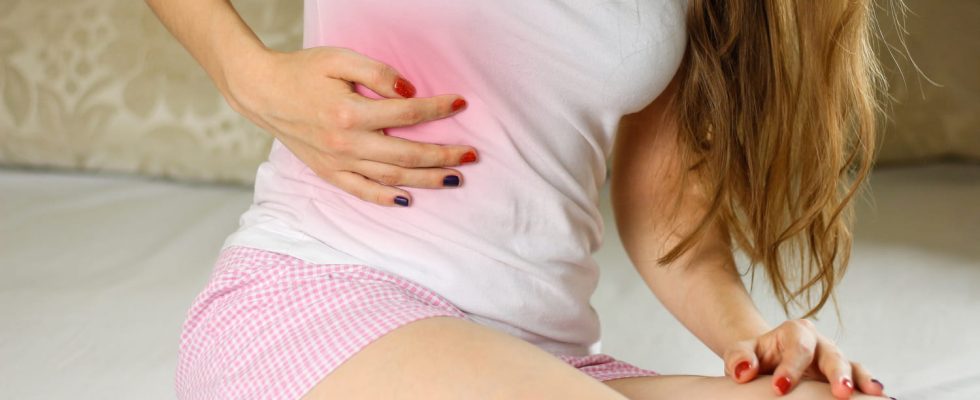Cholecystitis is an inflammation of the gallbladder. What are its symptoms? Its causes? Its possible complications? How to treat it?
Cholecystitis is a inflammation of the gallbladder wall. She may be acute or chronic. When it is acute, it is manifested by symptoms such as abdominal pain, fever or loss of appetite. There cause cholecystitis is biliary in the majority of cases. What are the complications possible? What treatments heal cholecystitis?
Definition: what is cholecystitis?
Cholecystitis is a inflammation of the gallbladder wall. It is most often the result of a specific or acute mechanism, following the obstruction of the cystic duct by a stone. Most of the time, the calculation is formed by clumping of crystals of cholesterol in a bile which is saturated with it. Cholecystitis can also be chronic, secondary to intermittent or partial obstruction of the cystic duct and progressively leading to thickening of the gallbladder wall.
What are the symptoms of cholecystitis?
The symptoms of acute cholecystitis of lithiasic origin are:
- Of the abdominal pain localized on the right or on the upper part of the abdomen. These pains are increased on palpation of the right hypochondrium, particularly during deep inspiration;
- Of the fever and chills ;
- A loss of appetite ;
- Of the nausea and/or vomiting.
Chronic cholecystitis is usually asymptomatic.
What are the causes and risk factors of cholecystitis?
As explained by Dr. William Berrebi, gastroenterologist in Paris “cholecystitis is of biliary origin in the majority of cases. The risk factors detailed below are those of cholesterol cholelithiasis, which is the most common since it affects 80% of cases..
► The women are more likely to have stones gallstones. This difference is more accentuated when they have had one or more children, insofar as bile contains more cholesterol during pregnancy, favoring the formation of stones.
► One overweight as well as a high-calorie diet promote the appearance of stones.
► The prolonged fasting promotes the formation of a vesicular lithiasis just like parenteral nutrition (intravenous nutrition) which does not solicit the digestive system at all, therefore the gallbladder. “100% of patients on total parenteral nutrition have cholelithiasis after one month” observes Dr. William Berrebi.
► Certain medications such as estrogen, cyclosporine, or cholesterol-lowering drugs may increase the formation of gallbladder stones.
► Certain populations such as the North American Indians, those of Chile or Scandinavian countries are more prone to developing gallbladder stones containing cholesterol. On the other hand, they are rarer in France.
► Hypertriglyceridemia.
► Gallstone disease is 2 to 3 times more common in people with MICI (chronic inflammatory bowel disease) such as Crohn’s disease.
“Much more rarely, cholecystitis may be due to a bacterial infection or occur in patients in serious condition in intensive care” says Dr. William Berrebi.
What are the complications of gallbladder inflammation?
The main progressive complications of acute cholecystitis are:
► Biliary peritonitis due to perforation of the gallbladder.
► Biliary fistulization in the small intestine (or more rarely the colon). “This fistulization can lead to a gallstone ileus, that is to say an intestinal obstruction in the event of a large stone” says the gastroenterologist.
What test to do to know if you have cholecystitis?
The doctor can practice a blood test looking for liver disorders and altered markers of inflammation. A blood test (NFS, ESR and C-reactive protein) will show an increase in white blood cells (neutrophils) and an increase in CRP and sedimentation rate. In the event of suggestive symptoms, the only essential examination, which makes it possible to carry out a positive diagnosis in more than 90% of the situations, is abdominal ultrasound. This examination highlights a thickening of the wall of the gallbladder as well as the visualization of the calculation(s). The appearance of pain blocking inspiration during the passage of the probe during the examination is an additional element to confirm the diagnosis. A scanner is sometimes considered in case of doubt. It highlights the inflammation of the walls of the gallbladder as well as its distension and can provide additional information in the context of a preoperative assessment.
What treatments to treat cholecystitis?
The treatment of biliary cholecystitis consists of taking antibiotics orally or intravenously followed by removal of the gallbladder (cholecystectomy) by laparoscopy.
“Once stones are present, no diet can dissolve them” explains Dr. William Berrebi. It is, however, possible to prevent their appearance by applying a few dietary rules. Being overweight is a factor favoring the onset of cholecystitis, the priority is to maintain a healthy weight (BMI between 20 and 25 kg/m2) by eating a healthy diet and practicing regular physical activity. A low fat diet is therefore recommended, so as not to put too much strain on the gallbladder. Indeed, in the presence of fat, it contracts to evacuate the bile necessary for their digestion, then risking pushing stones into the bile ducts.
Furthermore, the cholesterol that promotes the formation of stones, it is best to limit foods that are rich in it. Finally, in people with diabetes, a strict blood sugar balancing is indicated.
Thanks to Dr. William Berrebi, gastroenterologist.
